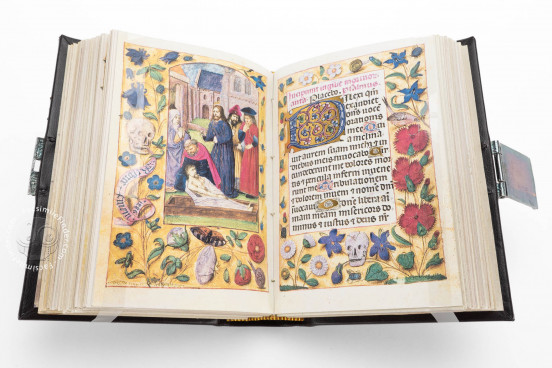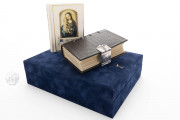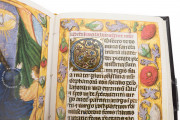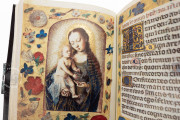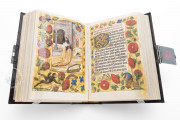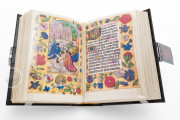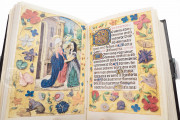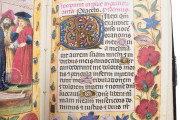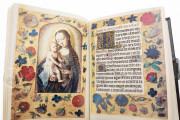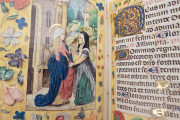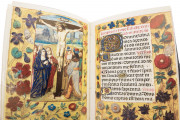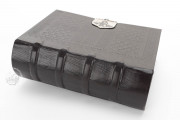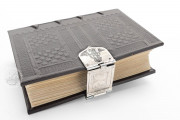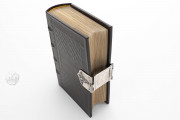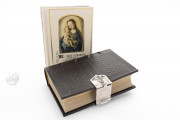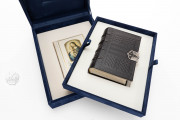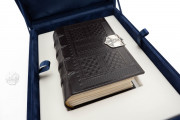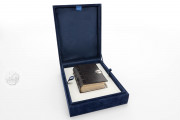The Hours of Gerard David—also known as the Escorial Hours—is distinguished by the artistic participation of its eponymous artist, Gerard David. It showcases some of the earliest known works of this renowned Flemish talent. Made in 1486, the deluxe manuscript was not, however, the work of Gerard David alone, but rather the product of a complex and intriguing collaboration involving other painters. A collection of Christian prayers for use in private devotions written in Latin, the manuscript is illuminated with sixteen full-page miniatures and four historiated initials.
The manuscript's characteristic Ghent-Bruges strewn-flower borders, which number thirty-three, are populated by flowers, insects, butterflies, birds, and snails, as well as amusing vignettes involving animals, humans, and hybrid creatures. All appear to cast shadows on the ocher-colored grounds. Human skulls also appear in the borders for the Office of the Dead (Escorial, fols. 136v-137r). One pair of borders, at the beginning of one of the hours of the Virgin (Escorial, fols. 78v-79r), presents instead a panoramic hunt scene, a curious complement to the miniature of the Annunciation to the Shepherds.
Sophisticated Collaboration
The manuscript showcases the complexity of manuscript production: while a particular face might be the work of one artist, the modeling of the same figure's body or the drapery of its garments would be painted by another. Although there are several hypotheses regarding the contributions of various artists to this splendid book, the most widely accepted is that Gerard David painted the images of the Salvator Mundi (New York) and the Virgin and Child (Escorial, fol. 30v), while the remainder of the miniatures were largely painted by the Master of Edward IV and his workshop, with David participating only intermittently, mainly to paint faces.
An Early Work of Gerard David
The original patron of this sophisticated manuscript is unclear. Its date, 1486, appears in a banderole found in the border of the miniature of The Raising of Lazarus that introduces the Office of the Dead (Escorial, fol. 136v). Gerard David's known activity in Bruges begins upon his admission into the local guild of image makers in 1484, and his contributions to the miniatures of the Escorial manuscript constitute some of his earliest work there. Although known principally as a panel painter, David continued to make contributions to the illumination of manuscripts, most famously in the Isabella Breviary and the Croy Hours.
Added Prayers and a Critical Look
Most of the text of the book, which is typical of a book of hours produced in Bruges at the time, is written in the Gothic Rotunda script preferred for liturgical and devotional books intended for export to Spain from the Netherlands.
The section of unilluminated prayers at the end (starting on the last line of fol. 229v) was written by two far less disciplined scribes in Gothic Hybrida. These scribes also added prayers at the front of the book. A note on the last page of the text (fol. 235r) reports that one Father Johannes Vidal saw the book in 1585.
An Iberian Binding?
The binding, which appears to be early, might offer a clue to the manuscript's original destination. The elaborate geometric decorative motifs ultimately derived from Islamic art stamped into the black leather suggest an Iberian origin. The binding features a silver clasp with an image of the Virgin and Child on the front and of the Visitation on the back. The miniature now in the Metropolitan Museum of Art came to the museum as a part of the collection of Robert Lehman (1891-1969).
We have 1 facsimile edition of the manuscript "Hours of Gerard David": Liber Horarum de Gerard David facsimile edition, published by Testimonio Compañía Editorial, 1998
Request Info / Price
